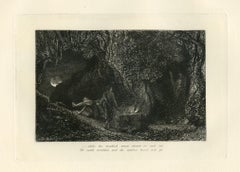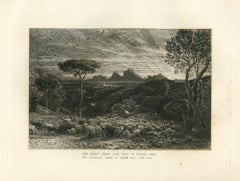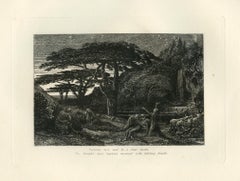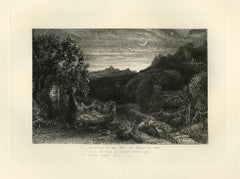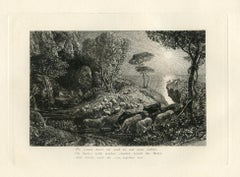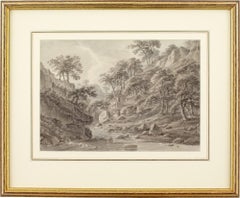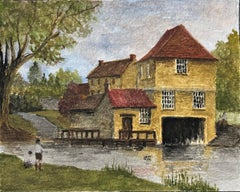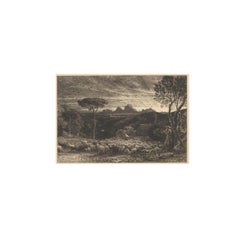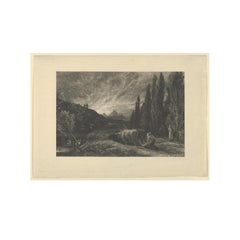Samuel Palmer (b.1805) Art
to
7
1
Overall Width
to
Overall Height
to
8
7
1
2
1
1
1
1
1
1
1
1
1
5
2
2
1
1
8
8,230
2,806
1,652
1,317
3
5
3
Artist: Samuel Palmer (b.1805)
"The Sepulchre" Eclogue 8 original etching
By Samuel Palmer (b.1805)
Located in Henderson, NV
Medium: original etching. This impression on Alton Mill laid paper was printed in 1883 for "An English Version of the Eclogues of Virgil" and published in London by Seeley and Compan...
Category
1880s Realist Samuel Palmer (b.1805) Art
Materials
Etching
"Opening the Fold - Early Morning" Eclogue 8 original etching
By Samuel Palmer (b.1805)
Located in Henderson, NV
Medium: original etching. This impression on Alton Mill laid paper was printed in 1883 for "An English Version of the Eclogues of Virgil" and published in London by Seeley and Compan...
Category
1880s Realist Samuel Palmer (b.1805) Art
Materials
Etching
Ancient Oak Trees in Lullingstone Park, Samuel Palmer Watercolour and Ink
By Samuel Palmer (b.1805)
Located in London, GB
Watercolour and pen and ink on paper, inscribed verso
Image size: 5 x 4 inches (13 x 10 cm)
Framed
This drawing most likely depicts a view in Lullingstone Park, near the village of ...
Category
Mid-19th Century English School Samuel Palmer (b.1805) Art
Materials
Ink, Watercolor, Pen
"The Cypress Grove" Eclogue 5 original etching
By Samuel Palmer (b.1805)
Located in Henderson, NV
Medium: original etching. This impression on Alton Mill laid paper was printed in 1883 for "An English Version of the Eclogues of Virgil" and published in London by Seeley and Compan...
Category
1880s Realist Samuel Palmer (b.1805) Art
Materials
Etching
"The Homeward Star" Eclogue 1 original etching
By Samuel Palmer (b.1805)
Located in Henderson, NV
Medium: original etching. This impression on Alton Mill laid paper was printed in 1883 for "An English Version of the Eclogues of Virgil" and published in London by Seeley and Compan...
Category
1880s Realist Samuel Palmer (b.1805) Art
Materials
Etching
"Moeris and Galatea" Eclogue 9 original etching
By Samuel Palmer (b.1805)
Located in Henderson, NV
Medium: original etching. This impression on Alton Mill laid paper was printed in 1883 for "An English Version of the Eclogues of Virgil" and published in London by Seeley and Compan...
Category
1880s Realist Samuel Palmer (b.1805) Art
Materials
Etching
A View Near Redhill, 19th Century Pen and Ink Drawing by Samuel Palmer
By Samuel Palmer (b.1805)
Located in London, GB
Pen and ink on paper, inscribed 'Redhill' and dated 'June 24th 1872' lower left
Image size: 4 x 8 inches (10 x 20 cm)
Mounted and Framed
Provenance
Given to Ernest Pearce by Carlos Peacock, from the collection of Miss Louisa Twining (1820-1911), a pupil of Samuel Palmer.
Carlos noted in his letter accompanying the work to Ernest Pearce that 'Going through my Palmer things for mounting the other day. I found this little sketch dating from the Redhill days. Thought you might like it by way of a Christmas gift'.
Literature
Carlos Peacock, Samuel Palmer , Shoreham and After, published by John Baker 1968, illustrated on page 67.
This delicate pen and ink drawing depicts a view at Redhill, a town in the borough of Reigate within the county of Surrey, England. While Palmer's reputation rests mainly on his Shoreham work some of his later work, such as his sketches from Redhill, have recently received more appreciation.
In 1872 Palmer was living in Redhill, at his last home, The Chantry at Cronks Hill. The Chantry is now Grade II listed due to the Palmer connection and Palmer Close, a cul-de-sac in Redhill (built in the 1960's), was also named in his honour.
This work is an illustration of rural paradise, a vision of the natural world where there is a cosmic harmony between man and his environment. Indeed, Alfred Palmer, the artist's son, wrote 'Had the artist depended for his material solely on the fields, and woods, and hills around him, and had he used that material in a sordid way, he might have given us faithful representations of those he selected, but there would have been inevitable repetition, and he would never have shown us as he has undoubtedly done, the very spirit and quintessence of the loveliest and most poetic pastoral scenery - scenery which we may imagine as that of ancient England...
Category
19th Century Samuel Palmer (b.1805) Art
Materials
Ink, Pen
Sketch-book Page, Shoreham, Samuel Palmer, Late 19th Century
By Samuel Palmer (b.1805)
Located in London, GB
Graphite on paper, numerous pencil inscriptions
Image size: 5 1/2 x 21 1/2 inches (14 x 55 cm)
Period style hand made gilt frame
Provenance
The collection of Ernest Pearce (1930-20...
Category
Late 19th Century Victorian Samuel Palmer (b.1805) Art
Materials
Paper, Graphite
Related Items
Amos Green, Near Ingleton, Yorkshire
Located in Cheltenham, GB
This fine early 19th-century watercolour by British artist Amos Green (1735-1807) depicts an asperous gorge near Ingleton in Yorkshire.
On either side of a shallow river, trees clin...
Category
Early 1800s English School Samuel Palmer (b.1805) Art
Materials
Watercolor, Ink, Paper
Historic Miniature Watercolor of Historic Toll Bridge at Bathampton
Located in Cirencester, Gloucestershire
Title: Historic Miniature Watercolor of Historic Toll Bridge at Bathampton
by Jack Grunwell, 20th century British artist
Medium: Watercolor on thin card, unframed
Measurements: 3.75 inches (height) x 4.25 inches (width)
Condition: Very good and highly presentable
Provenance: From a large private collection of this artists work in Bristol, England.
Description:
This evocative watercolor by Jack Grunwell captures the Bathampton Toll Bridge, a charming historic landmark nestled along the Kennet and Avon Canal near Bath, England. Bathampton, a picturesque village, is known for its scenic waterways, Georgian heritage, and tranquil rural charm.
Grunwell’s use of warm golden hues for the tollhouse and the reflective shimmer of the water creates a sense of nostalgia and serenity. The architecture, with its distinctive red roof and Georgian-style windows, showcases the character of 18th and 19th-century buildings that once served as essential river crossings for travelers and traders.
Bathampton is steeped in history, with connections to Jane Austen, the Kennet and Avon Canal, and the grandeur of Bath’s Georgian architecture. This scene perfectly encapsulates the timeless beauty of the English countryside, making it an ideal piece for collectors who appreciate historic British landscapes, waterways, and heritage architecture.
Key Features:
Historical Significance: Depicts Bathampton’s Toll Bridge and historic tollhouse, an important local landmark.
Rich Color Palette: Warm ochres, deep greens, and soft blues create a beautifully balanced composition.
Architectural Charm: The traditional riverside building with Georgian influences adds to its period authenticity.
Tranquil Setting: A peaceful riverside view, ideal for lovers of English countryside art...
Category
20th Century English School Samuel Palmer (b.1805) Art
Materials
Watercolor
$72 Sale Price
30% Off
H 3.75 in W 4.25 in D 1 in
SALVO, Landscape, Color aquatint
Located in Torino, IT
Landscape, 1990
Original aquatint and aquatint signed by hand by the artist.. (mm. 450x540).
Perfect specimen, imprinted on Hahnemühle paper in a total of 100 copies Perfect preserv...
Category
1990s Realist Samuel Palmer (b.1805) Art
Materials
Aquatint
Glastonbury Abbey
By Frederick Nash
Located in Middletown, NY
Ink wash with watercolor in sepia and black, and blue, on buff wove watercolor paper, 14 1/4 x 10 1/4 inches (360 x 260 mm). 1/4" of the lower right corner is lost, minor crack (doe...
Category
Mid-19th Century English School Samuel Palmer (b.1805) Art
Materials
Ink, Watercolor, Handmade Paper
Philip Pearlstein 'View Over Soho, Lower Manhattan' NYC signed, print
By Philip Pearlstein
Located in San Rafael, CA
Philip Pearlstein (1924-2022)
View Over Soho, Lower Manhattan, 1977
Aquatint in colors on wove paper
Edition 7/41
Signed, editioned and titled in pencil lower left
Printed by the Orl...
Category
1970s Realist Samuel Palmer (b.1805) Art
Materials
Aquatint
$3,000
H 37.5 in W 47.375 in D 1.5 in
Pair of Early 19th Century "Conchology" Conch Shells Color Etchings c.1802
Located in San Francisco, CA
Pair of Early 19th Century "Conchology" Color Etchings c.1802
Fantastic pair of hand colored etchings titled "Conchology".
Published in London on December 24th, 1802.
Each plate s...
Category
Early 19th Century Realist Samuel Palmer (b.1805) Art
Materials
Engraving, Aquatint
$650
H 16.25 in W 12.5 in D 2 in
English School watercolour, Figures on a country track with a castle beyond
Located in Harkstead, GB
A lovely rural scene with figures walking on a country track, pausing for a moment to chat and gaze over towards the castle in the woods.
Circle of William Leighton Leitch (1804-188...
Category
Mid-19th Century English School Samuel Palmer (b.1805) Art
Materials
Paper, Watercolor, Pencil
$278 Sale Price
20% Off
H 6.5 in W 10 in D 1 in
Circle of George Chinnery, 19th Century, Chinese Sumo wrestlers in a landscape
Located in Harkstead, GB
A fascinating 19th century view of Chinese Sumo wrestlers in a mountainous landscape
Circle of George Chinnery (1774-1852)
Chinese wrestlers in a land...
Category
Mid-19th Century English School Samuel Palmer (b.1805) Art
Materials
Paper, Watercolor
$559 Sale Price
30% Off
H 6 in Dm 8.5 in
SALVO, March, Color aquatint
Located in Torino, IT
SALVO (SALVATORE MANGIONE), Leonforte 1947 - Turin 2015
March, ca. 1990.
Original aquatint and aquatint hand-signed by the artist. (cm. 53x48). Paper size: cm.80x60
Perfect specimen,...
Category
1990s Realist Samuel Palmer (b.1805) Art
Materials
Aquatint
The Corner of Cheyne Walk, Chelsea - 19th Century British Etching by Roussel
By Theodore Roussel
Located in London, GB
THEODORE CASIMIR ROUSSEL, RBA
(1847-1926)
The Corner of Cheyne Walk, Chelsea
Etching, unsigned, with the artist’s tab, signed in the plate, trimmed to th...
Category
1880s Realist Samuel Palmer (b.1805) Art
Materials
Etching
$1,390
H 5.12 in W 7.49 in
A Galway Peasant (also, An Irish Peasant)
By Gerald Leslie Brockhurst
Located in New York, NY
Gerald Brockhurst (1890-1978), A Galway Peasant (also, An Irish Peasant), etching, 1920, signed in pencil lower right. Reference: Fletcher 10, from the edition of 55, third state (of...
Category
1920s Realist Samuel Palmer (b.1805) Art
Materials
Etching
Evening - The depth of the visible -
Located in Berlin, DE
Max Clarenbach (1880 Neuss - Cologne 1952), Evening. Etching, 18 x 41 cm (platemark), 33.5 x 57 cm (frame), inscribed "Abend" in pencil at lower left, signed and dated "M. Clarenbach. 28.III.[19]09". Framed and mounted under glass.
- Somewhat browned and slightly foxed.
About the artwork
The horizontally elongated etching depicts the panoramic view of a small town as seen from the other side of the river. There are gabled houses on the left and a mighty church spire on the right. The bourgeois houses and the large religious building indicate the urban character. These buildings are rendered in dark tones to emphasise the lighter row of houses in the centre of the picture, closer to the water. The chiaroscuro contrast creates two parallel planes that open up a space for the imagination of what the city could be. The imagination is stimulated by the almost entirely dark, barely recognisable buildings, while the arm of the river leading into the city further stimulates the imagination.
However, as the silhouette of the city as a whole is reflected in the water, the parallel planes are perceived as a band of houses that stretches across the entire horizontality of the etching and seems to continue beyond the borders of the picture. The reflection has almost the same intensity as the houses themselves, so that the band of buildings merges with their reflection to form the dominant formal unit of the picture. Only the parallel horizontal hatching creates the convincing impression of seeing water, demonstrating Max Clarenbach's mastery of the etching needle.
The water is completely motionless, the reflection unclouded by the slightest movement of the waves, creating a symmetry within the formal unity of the cityscape and its reflection that goes beyond the motif of a mere cityscape. A pictorial order is established that integrates everything in the picture and has a metaphysical character as a structure of order that transcends the individual things. This pictorial order is not only relevant in the pictorial world, but the picture itself reveals the order of the reality it depicts. Revealing the metaphysical order of reality in the structures of its visibility is what drives Clarenbach as an artist and motivates him to return to the same circle of motifs.
The symmetry described is at the same time inherent an asymmetry that is a reflection on art: While the real cityscape is cut off at the top of the picture, two chimneys and above all the church tower are not visible, the reflection illustrates reality in its entirety. The reflection occupies a much larger space in the picture than reality itself. Since antiquity, art has been understood primarily as a reflection of reality, but here Clarenbach makes it clear that art is not a mere appearance, which can at best be a reflection of reality, but that art has the potential to reveal reality itself.
The revealed structure of order is by no means purely formalistic; it appears at the same time as the mood of the landscape. The picture is filled with an almost sacred silence. Nothing in the picture evokes a sound, and there is complete stillness. There are no people in Clarenbach's landscape paintings to bring action into the picture. Not even we ourselves are assigned a viewing position in the picture, so that we do not become thematic subjects of action. Clarenbach also refrains from depicting technical achievements. The absence of man and technology creates an atmosphere of timelessness. Even if the specific date proves that Clarenbach is depicting something that happened before his eyes, without the date we would not be able to say which decade, or even which century, we are in. The motionless stillness, then, does not result in time being frozen in the picture, but rather in a timeless eternity that is nevertheless, as the title "Abend" (evening), added by Clarenbach himself, makes clear, a phenomenon of transition. The landscape of the stalls is about to be completely plunged into darkness, the buildings behind it only faintly discernible. The slightly darkened state of the sheet is in keeping with this transitional quality, which also lends the scene a sepia quality that underlines its timelessness. And yet the depiction is tied to a very specific time. Clarenbach dates the picture to the evening of 28 March 1909, which does not refer to the making of the etching, but to the capture of the landscape's essence in the landscape itself.
If the real landscape is thus in a state of transition, and therefore something ephemeral, art reveals its true nature in that reality, subject to the flow of phenomena, is transferred to an eternal moment, subject to a supra-temporal structure of order - revealed by art. Despite this supratemporality, the picture also shows the harbingers of night as the coming darkening of the world, which gives the picture a deeply melancholy quality, enhanced by the browning of the leaf.
It is the philosophical content and the lyrical-melancholic effect of the graphic that give it its enchanting power. Once we are immersed in the image, it literally takes a jerk to disengage from it.
This etching, so characteristic of Max Clarenbach's art, is - not least because of its dimensions - a major work in his graphic oeuvre.
About the artist
Born into poverty and orphaned at an early age, the artistically gifted young Max Clarenbach was discovered by Andreas Achenbach and admitted to the Düsseldorf Art Academy at the age of 13.
"Completely penniless, I worked for an uncle in a cardboard factory in the evenings to pay for my studies.”
- Max Clarenbach
At the academy he studied under Arthur Kampf, among others, and in 1897 was accepted into Eugen Dücker...
Category
Early 1900s Realist Samuel Palmer (b.1805) Art
Materials
Etching
Previously Available Items
Opening the Fold
By Samuel Palmer (b.1805)
Located in London, GB
Samuel Palmer
Opening the Fold
1880/1926
Etching
Image size: 16.4 x 23 cms (6 1/2 x 9 ins)
Category
19th Century Samuel Palmer (b.1805) Art
Materials
Etching
'The Early Ploughman' or 'The Morning Spread upon the Mountains'
By Samuel Palmer (b.1805)
Located in London, GB
Samuel Palmer
'The Early Ploughman' or 'The Morning Spread upon the Mountains'
1861
Etching
27 x 36 cms (10.6 x 14.2 ins)
Category
19th Century Samuel Palmer (b.1805) Art
Materials
Etching
The Rising Moon' or 'An English Pastoral'
By Samuel Palmer (b.1805)
Located in London, GB
Samuel Palmer
The Rising Moon' or 'An English Pastoral'
1857
Etching
26.8 x 36.5 cms (10.6 x 14.8 ins)
Category
1850s Samuel Palmer (b.1805) Art
Materials
Etching
The Sleeping Shepherd
By Samuel Palmer (b.1805)
Located in London, GB
Samuel Palmer
The Sleeping Shepherd
1857
Etching
36.5 x 26.8 cms (14.4 x 10.6 ins)
Category
1850s Samuel Palmer (b.1805) Art
Materials
Etching
The Herdsman's Cottage, or, Sunset
By Samuel Palmer (b.1805)
Located in Storrs, CT
The Herdsman's Cottage, or, Sunset. 1888. Etching. Lister 3.ii. Image 3 7/8 x 3; plate 4 7/8 x 4; sheet 9 x 6 3/4 inches. As published in, The Portfolio , 1872. Illustrated: Print Collector's Quarterly 3 (1913): 213. A rich impression printed on cream laid paper. Signed with the artist's 'S. P.' monogram in the plate along the lower left margin. Housed in an archival mat, suitable for framing. Housed in a 20 x 16-inch archival mat, suitable for framing.
The plate was not published until 1872, when Philip Gilbert Hamerton included it in The Portfolio. In 1875, Hamerton published it in his book, Examples of Modern Etching. In 1880, he published it for a third time in his seminal book, Etching and Etchers. The plate for this etching is known to have been destroyed by 1882.
The son of a bookseller, Samuel Palmer began painting at the age of thirteen. One year later he exhibited at the Royal Academy. In 1826 he moved to the remote village of Shoreham in Kent where he and such fellow artists as George Richmond and Edward Calvert...
Category
Late 19th Century Old Masters Samuel Palmer (b.1805) Art
Materials
Etching
Samuel Palmer (b.1805) art for sale on 1stDibs.
Find a wide variety of authentic Samuel Palmer (b.1805) art available for sale on 1stDibs. You can also browse by medium to find art by Samuel Palmer (b.1805) in etching, ink, pen and more. Not every interior allows for large Samuel Palmer (b.1805) art, so small editions measuring 4 inches across are available. Customers who are interested in this artist might also find the work of Antoine-Louis Barye, Eileen Soper, and William Nicholson. Samuel Palmer (b.1805) art prices can differ depending upon medium, time period and other attributes. On 1stDibs, the price for these items starts at $750 and tops out at $30,675, while the average work can sell for $1,000.
